Report on Akan (Japan) — August 1982
Scientific Event Alert Network Bulletin, vol. 7, no. 8 (August 1982)
Managing Editor: Lindsay McClelland.
Akan (Japan) Local seismicity declines
Please cite this report as:
Global Volcanism Program, 1982. Report on Akan (Japan) (McClelland, L., ed.). Scientific Event Alert Network Bulletin, 7:8. Smithsonian Institution. https://doi.org/10.5479/si.GVP.SEAN198208-285070
Akan
Japan
43.384°N, 144.013°E; summit elev. 1499 m
All times are local (unless otherwise noted)
Local seismicity gradually declined, returned to its usual level by mid-April (figure 1), and has remained there through July. Monthly numbers of recorded seismic events are: March, 411; April, 92; May, 16; June, 54; and July, 16.
Geological Summary. Akan is a 13 x 24 km caldera located immediately SW of Kussharo caldera. The elongated, irregular outline of the caldera rim reflects its incremental formation during major explosive eruptions from the early to mid-Pleistocene. Growth of four post-caldera stratovolcanoes, three at the SW end of the caldera and the other at the NE side, has restricted the size of the caldera lake. Conical Oakandake was frequently active during the Holocene. The 1-km-wide Nakamachineshiri crater of Meakandake was formed during a major pumice-and-scoria eruption about 13,500 years ago. Within the Akan volcanic complex, only the Meakandake group, east of Lake Akan, has been historically active, producing mild phreatic eruptions since the beginning of the 19th century. Meakandake is composed of nine overlapping cones. The main cone of Meakandake proper has a triple crater at its summit. Historical eruptions at Meakandake have consisted of minor phreatic explosions, but four major magmatic eruptions including pyroclastic flows have occurred during the Holocene.
Information Contacts: JMA, Tokyo.


